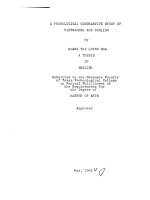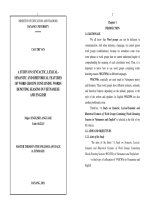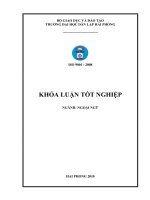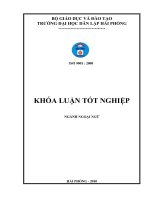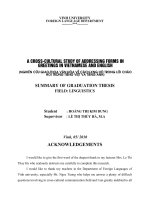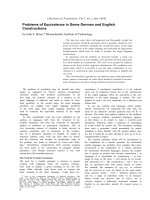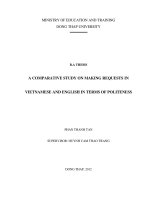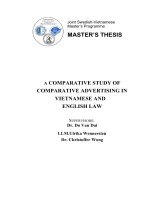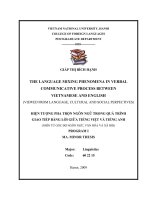figures of substitution used in the language of advertising in some vietnamese and english advertisements = các phép tu từ thay thế được dùng trong ngôn ngữ quảng cáo qua một số quảng cáo bằng tiếng việt và tiếng anh
Bạn đang xem bản rút gọn của tài liệu. Xem và tải ngay bản đầy đủ của tài liệu tại đây (1.17 MB, 52 trang )
VIETNAM NATIONAL UNIVERSITY
UNIVERSITY OF LANGUAGES& INTERNATIONAL STUDIES
FACULTY OF POST GRADUATE STUDIES
LUU THI THU HA
AN ACTION RESEARCH ON USING THE COMIC BOOK CALVIN
AND HOBBES TO MOTIVATE NON-MAJOR STUDENTS AT AIC
AMERICAN INTERNATIONAL SCHOOL TO LEARN
VOCABULARY
( Nghiên cứu về cách sử dụng truyện tranh Calvin and Hobbes để khuyến khích học
viên không chuyên tại trường Quốc tế Mỹ học từ vựng)
M.A MINOR THESIS
FIELD. ENGLISH TEACHING METHODOLOGY
CODE.
SUPERVISOR. DO TUAN MINH (Ph.D)
Hanoi, 20
th
May 2010
iv
CONTENT TABLE
CONTENTS
PAGES
DECLARATION
i
ACKNOWLEDGEMENT
ii
ABSTRACT
iii
LIST OF TABLES
iv
Chapter 1: Introduction
1-3
A. Statement of Problems……………………………………………….
1
B. Purpose of the Study…………………………………………………
2
C. The Significance of the Study………………………………………
2
D. Theoretical Frame Work …………………………………………….
3
1. How do Calvin and Hobbes comics help students at AIC learn
vocabulary? …………………………………………………………
2. What are the students’ attitudes toward learning vocabulary through
the comic? ……………………………………………………………
3. What are the problems faced by students when learning vocabulary
through the comic? …………………………………………………….
Chapter 2: Literature Review
4-10
A. Overview …………………………………………………………….
4
B. Literature Review ……………………………………………………
1. Aspects of the vocabulary teaching …………………………………
2. “Motivation” in English language teaching……………………………
4
5
v
3. The use of comic in teaching vocabulary …………………………….
4. Background about Calvin and Hobbes comic…………………………
6
8
C. Conclusion…………………………………………………………
10
Chapter 3: Research Design and Methodology
11-13
A. Design of the Research……………………………………………
11
B. The Sample…………………………………………………………
11
C. Description of Instruments…………………………………………
11
D. Procedure of the Observations and the Interviews…………………
12
E. Pilot Testing………………………………………………………….
12
F. Research Schedule……………………………………………….
12
G. Methodology……………………………………………………
13
Chapter 4: Results and Discussion
17-29
A. Overview …………………………………………………….
17
B. Result…………………………………………………………….
17-27
1. Results of Questionnaire…………………………………………
1.1. Characters…………………………………………………
1.2. Students’ Ratings of the Comic Appeal………………….
1.3. Measurement of Students’ Perceived Learning
2. Observations Result……………………………………………
27
3. Interview Result…………………………………………………
28
C. Discussion………………………………………………………
29
Chapter 5: Recommendation
32-34
A. Summary of Findings………………………………………………
32
B. Recommendations………………………………………………….
33
vi
1. Teachers should show their enthusiasm for the comic
first…………………………………………………………………………….
2. Choose Your Comic Carefully……………………………………
3. Be more active and creative………………………………………
C. Limitation and Suggestion for Further Research……………………
34
Chapter 6. References
A. Book Source…………………………………………………………
B. Internet Source………………………………………………………
36
Appendices
I- XVII
vii
LIST OF TABLES
TABLES
PAGES
Table 1: Student Perceptions of Comic Appeal……………………
20
Table 2. Text difficulty……………………………………………
20
Table 3. Learning activities………………………………………………
22
Table 4. Comic’ suitability………………………………………………
23
Table 5. Effectiveness of the method…………………………………….
24
Table 6. Substitute material for teaching…………………………………
25
Table 7. Engagement into the lesson …………………………………
26
Table 8. Enhance the relationship………………………………
26
1
CHAPTER 1. INTRODUCTION
A. Statement of Problems
Learners at the American International College (AIC) study English as a foreign language.
Their ages fluctuate from nineteen to thirty. Although they are keen on learning English, they
are often off-task and not using their time effectively, or ―being stuck‖ and not knowing what
to do next. When teaching I noticed that many of them did not have the strategies or tools
they need to proceed in writing or reading. While observing the students reading for
details, speaking to communicate, or convey a given massage; they ask a lot about words
they do not know or words they need to use. Therefore, I began to go through my own
materials that I had collected in training sessions and look for good strategies for
teaching vocabulary, writing process, and classroom management. Bearing in my mind, it
is important for people to take responsibility for their learning and productivity in order to
be positive contributors in and outside the classroom. What could I do as a teacher to help
students develop the skills they need to take responsibility?
Comic Books took my interest in reading, and they also helped me in the subject of English.
Although some teachers thought that there were a lot of slang words and misspelling, comics
were and still are proof read and checked for misspellings, grammar and punctuation.
Nevertheless, many successful English teachers say that one of the most important aspects of
teaching English is making it fun and interesting. Finding applicable techniques that students
can relate to and have fun doing so is quite a chore. The teaching could be so boring and
difficult without using interesting materials.
Although we usually associate comics with entertainment, in fact they can have many more
serious applications. Everybody loves comics - as we all know from the fondness they have
for the comics - so why not make this attractive medium work for teaching and learning?
Comic materials have been found to be highly motivational for improving language. Spector
(1992) insisted that ―it is vital for reading programs to provide plenty of opportunities for that
one of the most difficult aspects of students to experience life‘s comical teaching English is
making it fun and nonsensical characters and events.‖
Using comic can be a part of successful teaching that may make students enjoy. Comic come
in a variety of forms and clearly demonstrate that a picture is often worth a thousand words.
Often comic contain written language, but even when they do not they can provide students
with numerous possible ties for learning English.
2
B. Purpose of the Study
The use of comic for teaching is explored more thoroughly. One of the more obvious
applications is to use comic to teach English and composition. The students read the comic,
and then discuss the plot, the characters, and the setting. They then write the story of what
they have done so far or their adjustment to the characters, ect.
As a teacher of the American International College, I regularly use comic to teach such topics
as vocabulary, sentence construction, grammar, part of speech as well as speaking and
translating. Using comic can be a part of successful teaching, making English a real enjoyable
as ―through the lesson students could learn something about skill choosing words, ability to
adopt linguistic accent, repertoire of jokes, imagination so on and so forth‖ (Peter Woods, p.
85)
C. The Significance of the Study
There are many factors that are important to how a student learns. These factors include the
following; how the teacher teaches the students, the curriculum the teacher uses, the
environment of the students, and the home-life of the students. However, students are rarely
asked what they think about how the type of material impacts their learning. In particular, the
importance of this study is to find out from the students, if they feel whether they can learn
best when they use students books in class for a period of time of 100 minutes or whether
they think they can learn better if they have additional material to work on. This study may
have value to several different groups. It can be valuable to the teacher, first and foremost,
because if a teacher can decide what kind of material for teaching and learning that goes on in
a class, impacts a students, the teacher may be able to make modifications within the
framework of the school schedule, that incorporate these ideas. Secondly, it might be
interesting in the future to continue this study with major students and see how the type of
material they have impacts their learning? Another potential study in the future might be to
interview teachers who teach the students books only and those who teach with additional
materials, and see what differences exist between these two materials in terms of their effect
to the teacher‘s attitude and their teaching methods.
D. Theoretical Frame Work
Learning is an extremely complex human process. During my five years of teaching I have
used many strategies to enhance students learning and to teach new concepts. I am still not
convinced that I thoroughly understand how students learn. Yet, at this point, I do believe
3
students learn through experiences. They build on past experiences and previous knowledge
to process new concepts. Students need to be actively involved in their education. Interested
and enthusiastic students are more willing learners, and I believe willing learners become
active participants in their own instruction. As students become more actively involved in
their learning, they develop interest and enthusiasm for the content and/or the process that is
their conduit for acquiring new knowledge.
During the process of conducting an action research on using Calvin and Hobbes in teaching
and learning English, the following questions should be answered simultaneously:
1. How do Calvin and Hobbes comics help students at AIC learn vocabulary?
2. What are the students’ attitudes toward learning vocabulary through the comic?
3. What are the problems faced by students when learning vocabulary through the
comic?
Through this study I hoped to find that the Calvin and Hobbes comic would be the material
that my students needed to acquire new knowledge, develop new concepts, and express
strong understanding in general. In particular, I will focus on how this comic influences the
usage of vocabulary as well as how their interaction is enabled. Also, the study will test the
usefulness of using picture-based text in teaching English of all levels. Through the attraction
and varieties of the comic, I hoped to tap the enthusiasm of my students towards learning
English and make them active participants in their own instruction.
4
CHAPTER 2. LITERATURE REVIEW
A. Overview
Learning is considered a serious matter in helping learners to develop, is still a need to liven
the process of understanding different concepts. Not only does humor offer a new type of
learning, but also is known to provide learners who are learning different topics with the
ability to remember different ideas at a more thorough level. If you have students who are
learning vocabulary, writing or reading, then using vocabulary comic is a simple way to liven
the learning process.
Even though most consider vocabulary comic as a secondary source or addition to the
learning process, many others have found that there are more to comic then meets the eye.
B. Literature review related to the study
1. Aspects of the vocabulary teaching
2. ―Motivation‖ and ―attitude‖ in English language teaching
3. The use of comic in teaching English
4. What is the origin of Calvin and Hobbes? Its characteristics?
1. Aspects of the vocabulary teaching
Vocabulary is the knowledge of words and word meanings. As Steven Stahl (2005) puts it,
"Vocabulary knowledge is knowledge; the knowledge of a word not only implies a definition,
but also implies how that word fits into the world." Vocabulary knowledge is not something
that can ever be fully mastered; it is something that expands and deepens over the course of a
lifetime. Instruction in vocabulary involves far more than looking up words in a dictionary
and using the words in a sentence. Vocabulary is acquired incidentally through indirect
exposure to words and intentionally through explicit instruction in specific words and word-
learning strategies. According to Michael Graves (2000), there are four components of an
effective vocabulary program:
wide or extensive independent reading to expand word knowledge
instruction in specific words to enhance comprehension of texts containing those
words
instruction in independent word-learning strategies, and
5
word consciousness and word-play activities to motivate and enhance learning
As a vocabulary teacher, we have to be focused on building the learner's 'start up' or initial
vocabulary, developing the learner's understanding of what learning words means, and
showing the learner how to learn the words most effectively.
With the comic, students can choose to study vocabulary directly through dictionary or
indirectly through studying activities. The ultimate aim, of course, is to develop the learners
as independent word learners; and hence improving their English proficiency.
2. “Motivation” and “attitude” in English language teaching
Motivation is often defined as the psychological quality that leads people to achieve a goal.
For language learners, mastery of a language may be a goal. For others, communicative
competence or even basic communication skills could be a goal.
In linguistics, sociolinguistics and second language acquisition, a number of language learner
motivation models have been postulated (www.wikipedia.org). Gardner and Lambert (1972)
distinguish between attitude and motivation. They define ‗attitude‘ as the persistence shown
by the learner in striving for a goal, where as ‗motivation‘ is seen in terms of the overall goal
or orientation. However, attitudes are related to motivation by serving as supports of the
learner‘s overall orientation. Brown (1981) uses the term ‗attitudes‘ to refer to the set of
beliefs that the learner holds towards members of the target language group and also towards
his own culture.
Stern (1983:376-7) distinguishes three types of attitudes in second language learning
situation : '(a) Attitudes towards the community and people who speak the L2 ( group specific
attitudes), (b)Attitudes towards learning the language concerned; and (c) Attitude towards
languages and language learning in general.' They may also be influenced by the particular
social milieu within which the language learning process takes place. Brown (1981) also
makes the distinction between attitude and motivation. He identifies three types of
motivation (1) Global motivation that consists of a general orientation to the goal of learning
a L2; (2) situational motivation, which varies according to the situation in which learning
takes place and (3) task motivation, which is the motivation for performing particular learning
tasks.
6
3. The use of comic in teaching vocabulary
Comics as an educational tool have held the attention of teachers and academia for quite
some time now. Coming from a tool to provide a non-animated entertainment to an age where
movies are being based on such hit series, comics are a serious multi-million dollar business
now. And, all the adulation is well deserved, comics fulfill the inherent ability of humans to
visualize something in a better fashion and retain it for a longer period of time. Over the next
decade, comics began gaining ground in the world of education, slowly finding its way into
the course catalogs of American higher learning institutions. Using comics, English teacher
Jenn Natalie (June 1, 2009 at 12.50pm) wrote in a teaching forum that ―I‘ve used Calvin &
Hobbes in my English courses in France. It makes an excellent vocabulary builder and
conversation tool. Plus it's fun to read! I also translated one of the strips in my German class
(it was a group project) - we then performed it as a sketch. In brief, C&H also works really
well in foreign language courses‖ ( />19991224/loose.dtd)
Today, educators at all levels are designing new ways of teaching through comics. Dozens of
schools across the world ordered the curriculum before it was even complete. The National
Association of Comics Art Educators evangelizes colleges and universities on the importance
of comics-based courses. Their website (www.teachingcomics.org) features the syllabi of
existing courses, instructional units written by comic writers and professors, and an online
community of comic‘s educators.
Comics have good reputation for its varieties which are said to be:
Motivating. By far, the most frequently mentioned asset of comics as an educational tool is
its ability to motivate students. Pictures tell any story more effectively than words. (Sones,
1944, p. 239)
Visual. Comics, being composed of "pictorial and other images" (McCloud, 1993, p. 9), is a
fundamentally visual medium. Pictures and text shoulder the burden of the story together. In
the struggle to engage students of all learning dispositions, comics can prove to be a
formidable tool.
7
Permanent. Williams (1995) cites comics' "permanent, visual component" (p. 2) as one of
his many reasons for using comic books in his ESL class.
Intermediary. Comics can serve as an intermediate step to difficult disciplines and concepts.
Many language arts educators have used comics in this manner with tremendous success.
Comics can also scaffold to disciplines and concepts outside of the language arts In addition
to reading and writing, comics-based projects can develop drawing, computer, and research
skills. Many of the skills used in comic‘s creation can be applied to film-making, illustration,
and even Web design (Sturm, 2002).
Popular. While some educators simply ignore this reality, many others struggle to address it
adequately. George Chilcoat (2002) suggests that, by incorporating popular culture into the
curriculum, teachers can bridge the separation many students feel between their lives in and
out of school.
Many teachers have discovered that when students associate an image with a word, they are
more likely to be able to retrieve that word and remember its meaning. To learn new words,
students must make connections between the new words and words or concepts they already
know. Visualizing a new word can help students make even stronger connections. The
cartoons could be used as models or springboards to get students to make their own word
cartoons. Moreover, comic language is real English which is said to be friendlier and much
easier to remember than those in the book. The reason why I choose Calvin and Hobbes as
one of the teaching materials in the class is the author of the story are very creative in bring
us the image of great water splashed, living room couches, chairs , lamps, yawns, screams,
and all the things that make the comic strip fun to look at. I like the thin, little arms and his
shoes that look like dinner roll. ―Calvin and Hobbes contain hilarious pictures that cannot be
duplicated in other mediums. In short, it is fun to look at‖ (Charles M. Schulz, quote on the
book). Together with the creative use of the vocabulary, Calvin and Hobbes comic has
become the most favorite teaching materials among teachers all over the world.
4. Background about Calvin and Hobbes comic.
Calvin and Hobbes was a daily comic written and illustrated by Bill Watterson, following the
humorous antics of Calvin, an imaginative six-year-old boy, and Hobbes, his energetic and
8
sardonic—albeit stuffed—tiger. Syndicated from November 18, 1985 until December 31,
1995, at its height Calvin and Hobbes was carried by over 2,400 newspapers worldwide. To
date, more than 30 million copies of 18 Calvin and Hobbes books have been printed.
The strip is vaguely set in the contemporary Midwestern United States, in the outskirts of
suburbia (West 1989). Calvin and Hobbes themselves appear in most of the strips though
several have focused on Calvin's family. The broad themes of the strip deal with Calvin's
flights of fantasy, his friendship with Hobbes, his misadventures, his views on a diverse range
of political and cultural issues and his relationships and interactions with his parents,
classmates, educators, and other members of society. The dual nature of Hobbes is also a
recurring motif; Calvin sees Hobbes as alive, while other characters see him as a stuffed
animal. Together, they meet many of the problems, gaining lots of bizarre insights and
misadventures along the way.
Bill Watterson, creator of Calvin and Hobbes, has certainly
made peanut butter out of his life. Born on July 5, 1958,
Watterson got a job as a political comicist at the Cincinnati
Post after he graduated with a degree in Political Science from
Kenyon College in 1980. Fired after six months, he worked at
an advertising firm for four years before he came up with Calvin and Hobbes. Some of the
people who have inspired him are Charles Schulz, Walt Kelly, George Herriman, and Winsor
McCay. From the Reuben Award in 1986, Watterson has won many awards, his last being the
Harvey Award in 1996. Worldwide sales of the book makes Watterson's heartwarming
depiction of precocious six-year-old Calvin and his imaginary, pouncing pet tiger Hobbes
unquestionably one of the most popular and beloved comics of all time.
Main Character List ( Pictures adapted from www.photobucket.com)
Calvin: The star of Calvin and Hobbes, Calvin is self-
centered and full of mischief, just like most 6 year old kids.
Highly imaginative and stubborn, he often runs into sticky
situations. With no siblings or friends, Calvin lives in his
own world of fantasy, pushing the limits of his freedom to
the extreme. When he gets into trouble, he points his finger
at Hobbes.
9
Hobbes: Hobbes is actually a stuffed tiger brought to
life by Calvin‘s imagination. Sort of a guardian angel,
he annoys Calvin with his philosophical ramblings
and jumps on him when nobody is around.
Calvin’s Parents: Like all parents, they want
the best for Calvin. Though they are mad at
him more often than usual, they love him all
the same. They have no real names, only being
known as Mom and Dad. Bill Watterson has
said that Calvins‘ dad is a satire of his own
father.
Susie Derkins: The girl next door, Susie
is head over heels in love with Calvin.
She is smart, kind and generous. Her
greatest wish is to be his friend and his
greatest thrill is to make fun of her. Bill
Watterson named this character Derkins after his
wives own family dog.
Miss Wormwood: Poor old Miss Wormwood is
approaching retirement. Since she‘s Calvin‘s teacher,
she‘s not so sure she will get there. She tends to
smoke and meditate when she feels stressed.
Rosalyn: Calvin is afraid of his babysitter,
Rosalyn. She‘s really brave because nobody
else would take the job. However, Calvin is
always plotting some sort of problem for her.
10
Moe: Moe loves to bully Calvin. Sometimes, he will pick Calvin
up and give him a beating. He usually ends up trying to steal
Calvin‘s allowance. However Moe is not the brightest crayon in
the box so Calvin always gets the last laugh.
I first met this interesting comic when it appeared at the last page of
the Vietnam News. Then I go deep insight discovering it in the website as well as in the
Consultant of United State Embassy in Hanoi where I can read books free of charge.
C. Conclusion
The resurgence of interest in this form of entertainment has spawned a host of texts and
magazines seeking to ride the wave on using comics for educational purposes. All of these
have taken advantage of the inherent characteristics that make this medium as attractive as an
educational tool. English now becomes more than a mere frill to a true vehicle to disseminate
one's ideas. With the emergence of such a need, comics can fill this gap because of its multi-
dimensional nature, combing both words and pictorial images. The study of using Calvin and
Hobbes in teaching English has never been conducted in any thesis in Vietnam but it is not
the new method among the teachers all over the world. So I do hope that doing this research
will help Vietnamese teachers know how to use these new materials in their professional
practices.
11
CHAPTER 3. RESEARCH DESIGN AND METHODOLOGY
A. Design of the Research
As the action research in a long lasting process that ―we
carry out with our students in order to try out an idea or
and innovation, test their hypothesis about learning and to
see what would happen‖ as Gina Wisker( p.156-2001)
mentioned, I would like to take a naturalistic research
approach to examine objects of study through qualitative
methods. The method is qualitative (words) with multiple
methods (triangulated data). During the evaluation study,
data was obtained from the participants, i.e. students and
teachers. After collecting the data needed through
questionnaires, observation, interviews and samples of
student work, the data were calculated and analyzed. In this respect, qualitative data is
essential. It focuses on real life problem.
B. The Sample
I conducted my study with students of the American International School which has location
in 68 Nguyen Hong Street, Hanoi. Currently I am teaching communicative English for four
classes of pre-intermediate level with approximately eighty students. Fifty of them were my
research participants.
I taught them twice a week for eight weeks, and will stay on to observe their work for
approximately 24 hours during the eight week period. My primary focus was on their
progression in using vocabulary which they learnt from the comic materials, although I also
observed (and perhaps enquired about) interactions during their other work.
C. Description of Instruments. I used reconstruction activities based on comics to get my
pre-intermediate level English students to interact with texts. I designed kinds of activities
and exercises with Calvin and Hobbes for use in the class. All the materials were downloaded
from the website www.photobucket.com which has more than 3000 comics and those I got
from the United State of American Consultant in Hanoi.
12
D. Procedure of the Observations and the Interviews
The student‘s questionnaire has three parts regarding on the following information:
background information, enjoyment experiment and helpful motivation. A sample
questionnaire of the students‘ survey and students‘ reflection on the studying method is
shown in the appendix.
The instrument used for calculating the result is SPSS which is well-known as the most
widely used programs for statistical analysis in social science. It is used by market
researchers, health researchers, survey companies, government, education researchers,
marketing organizations and others. In addition to statistical analysis, data management (case
selection, file reshaping, creating derived data) and data documentation (a metadata
dictionary is stored in the data file) are features of the base software.
E. Pilot Testing
Once instruments were developed, the study was piloted in November 2009 with students in
the AIC College in Hanoi in order to test and refine instruments for full-scale implementation.
Seventeen students participated in the pilot, during which time researchers asked students to
identify confusing questions in the survey. Researcher also tested out an implementation
protocol for directing the students through the study. The pilot revealed that most instrument
items were not confusing for students, and required only minor wording changes to clarify
meaning for a few items on the survey ( say: reorder the story and rearrange the paragraph are
the same, so one had to be omitted). Researcher also changed the implementation protocol to
include reading aloud the surveys to support student understanding of instrument items.
F. Research Schedule
The study was conducted in January 2009 to compare students‘ ability of using language
before and after the application of the comic.
For the researcher:
1. Design the activities and survey questionnaire to gather information from the students.
2. Conduct the experimental activities for one and a half hour per lesson, two lessons per
week during eight weeks.
For the students:
1. Did the activities with the comic in assigned tasks
2. Responds to surveys and interview to gather information about their measurement of
language perceived and their opinions about studying with the comic.
13
In order to gather additional qualitative data from participants, during the study the
information on observable student behaviors and performance in the class were also gathered.
G. Methodology
Comics can be used from beginner level to advanced level for a variety of language and
discussion activities. They are powerful teaching tools and can be used to: tell a complex
story in a few images, provide comment and provoke thought on events and issues in the
news, give an example of vocabulary related to current trends and fads, provide easily
identifiable characters to form the basis for sketches, show culture in action with the ways
that people are behaving and are expected to behave. While the characters Calvin, the young
human, and Hobbes, his imaginary Tiger sidekick, are immature by nature, they use a wide
variety of language to which students are seldom exposed. By using comic with characters
with which the students could identify, I designed the activities as the following (note that all
the activities listed were mixed during the conducting period).
Activity 1. Create a written story based on the picture
I removed speech from a comic. Cut them up and gave out. Then I asked them to order and to
imagine what the story or situation is. Groups act out their version for the class. The purpose
of this activity is for them to tap into their creativity and flexibility when using comics. This
student learning activity using comics should be fun and relaxed. This will help students who
have difficulty with creative writing.
Activity 2. Aim. To practice telling the story of a sequentially-ordered comic that has been
scrambled up and to reinforce the use of time-sequence transition words to maintain the unity
of a paragraph or story (e.g., First, the boy left for school. Next…)
I cut up the pictures and got students to reorder the story. I made this more difficult and
challenging linguistically by giving separate frames to each student in a group and asked
them to not show the pictures until they had arrived at an order through describing the
pictures. Then, I removed the last picture of a comic and asked students to think of an ending.
Students voted for the best ending.
Activity 3. Aim. To help student recognize word reductions in written text, identify the
corresponding long form, and practice these reductions orally
14
I gave students a comic with a short paragraph for each frame. Ask students to reduce each
paragraph to one sentence for each frame. Compare their efforts to the original. With higher
levels I have them discussed about techniques of summarizing the message.
Activity 4. Fill in the blank
I wanted to allow students to be creative, relaxed, and productive. I asked them to write
sentence descriptions of what happened in each frame of a comic in which little or no text
appeared. They were required to describe each aspect of the comic and draw conclusions.
Activity 5. Exploit the topic inside
I chose a key situation which would involve language students might need to practice, such as
agreeing with opinions, asking permission or saying you are sorry. Students need to
remember the words with respect to the topic. While the comic provides little written text, it
does provide the teacher an opportunity to teach an expression for which most students are
completely unfamiliar, as well as open the door to finding out why Calvin would have such a
sarcastic expression.
I asked students to notice words they didn‘t know yet and tried to figure out what they mean
by the context. Then they made a dialogue using the words that they had found out.
Activity 6. Comics also often lend themselves to functions lessons In this activity, I created
games to develop vocabulary and identify parts of English sentences. Students were divided
into teams and required to write their vocabulary down within an allotted timeframe. A
similar activity involved the same teams identifying as many different parts of speech within
the comic as possible. We used four major categories, nouns, verbs, adjectives, and adverbs,
because those were the categories we had already discussed. By using these types of
activities, I was able to promote active learning through a medium in which students
maintained active interest.
Activity 7. Exploit characters
After doing a set of tasks, I asked the students to do the following set of tasks:
Describe one of your favorite characters in the story ( Calvin, Hobbes, Susie, Mrs.
Woodworm, Calvin‘s parents, ect. ): appearance, character. Retell one of your most favorite
15
stories. Why do you like it? What makes the character special? What are their weaknesses?
What do they look like? Then ask each group or pair to choose a favorite character and make
a simple situational dialogue which is typical for them. The final stage is to tell an everyday
story involving the character.
Activity 8. Aim. To learn the culture-specific words and phrases, synonyms and antonyms to
expand vocabulary
Comics are a great way to learn new vocabulary and slang. I asked students to make a special
Calvin and Hobbes Vocabulary Notebook. Then the students wrote all the vocabulary and
slang that they had learnt from C and H. If they could not understand a word, they would try
to figure it out from the context of the comic before using the dictionary.
Activity 9. Grammar building
The idea was to keep the process simple while developing their creativity. As the students
wrote with greater ease and success, I began using the comic to teach sentence construction
and grammar. Using the comic and the descriptions the students had written, I was able to use
the students' own writing to teach nouns, verbs, and grammar. We also looked at topics such
as subject-verb agreement, reported speech, direct speech (e.g., Hey, move your car!) and
reported speech (The man said, "Move your car!"); as well as article and preposition use.
Then students would practice formation of different verb tenses (i.e., changing the present
tense of the action in the strip to the past tense).
Activity 10. Rearrange the paragraph
Still later I was able to provide students with the entire paragraph written incorrectly, and the
students had to reorganize the paragraph so that the sentences flowed in an order that was
appropriate. I tried to improve students' listening by asking them reading aloud what they had
done.
Activity 11. Vote for the best comic
16
Which comic do you think is the funniest? After you read some of these comics, try to make
your own comic! Think of an interesting word or phrase. Students exchange papers in their
groups, read each other's ideas, and then vote on the best story. Comics are particularly useful
because they have pictures to accompany what might otherwise be somewhat dense language
(particularly with Calvin).
Activity 12. Aim. To practice describing characters using adjectives (e.g., Calvin is a very
creative boy);
I assigned students to work in small groups (preferably three to a group) then I gave them the
comic. I asked students to take turns discussing the action in the story, paying special note to
facial expressions, gestures, setting, etc. I then had students down a list of five things they
saw in each frame, focusing on new lexicon. For homework, I assigned each student to write
down his or her own predictions on how the story begins and ends, in three sentences.
Activity 13. To introduce paralanguage lexical items without a written correlate (e.g., Uh-oh,
you're in trouble now for lying to Mom; Pssst. What's the answer to number five on the test;
Uh, let me see). Paralanguage is perhaps the most used, yet most pervasive, language form,
and many teachers are slow to introduce them because they are not aware of how much these
items permeate everyday language. Fortunately, comics are rich in paralanguage content.
Activity 14. Aim. Use comics as writing prompts for students.
I allowed students to pick a comic that would be the basis for the characters and plot of a
short story. I also remind students that when writing a short story the character's reactions to
events make the story more interesting and move the story along. The story should have a
definite beginning, conflict, rising action, climax, falling action, and denouement.
Activity 15. I had students write a short paragraph interpreting the comics. I had to instruct
them to use good grammar and spelling. I used the written work to evaluate the students'
progress in writing and grammar.
17
CHAPTER 4. RESULTS AND DISCUSSION
A. Overview
Questionnaire are designed to find general evaluation of study by responding
participants (in percent)
Used device for the first time
Enjoyment experiment (yes, not, uncertain or no answer)
Found helpful for motivation
Increased individual participation
Helped student- teacher relations
Increased interesting in reading
At first I intended to use both teachers‘ survey and students‘ survey for the research.
However, when going further, it came out that not every English teacher knew about this
famous comic let alone as using it in their academic performance. Also no teacher helps me
in using the worksheets I prepared for them so I decided to omit the teacher‘ surveys.
Also I found out that some stories do not appropriate to students in terms of children behavior
and Vietnamese context. So I had to read the stories carefully and choose the appropriate
ones before using.
B. Result
1. Results of Questionnaire.
1.1 Characters
The survey asked students whether or not they liked the characters and to explain why they
did or did not like them. A majority of students said that they liked the characters (80%),
with no significant differences by gender and comic format (N=50). Students who liked the
characters provided 30 comments about why they liked the characters. The top reasons are as
follows:
The majority of students thought that the characters were funny/entertaining (33.3 %).
Some students liked that the characters because they were ―human-like‖ (26.7%).
Students liked that the characters explained information (6.7%).
Students also liked that the characters were lovely (33.3).
The following quotes further illustrate what students liked about the characters:
The characters all had a personality, even Hobbes, a stuffed animal. They were funny
and acted like humans.
18
Hobbes was kind of animal-like and that caught my eye.
They explained stuff that you might not know.
Calvin and Hobbes are good character, they are so lovely though naughty.
Calvin was funny. He always try to behave well to get X’mas present from Santa.
I thought that they were very funny and interesting. But the guy was a little creepy. If
I were the woman, I would have flipped out on that fool!
The characters gave me a good image so I could understand what was going on in the
story.
Respondents who said they did not like the characters (20%) gave 10 comments explaining
why they did not like the characters. Of those who did not like the characters, their top
reasons were:
Students thought the characters were not funny (10%)
Some students did not like children story (50%)
Some thought that studying with comic is not effective (40%)
1.2. Students’ Ratings of the Comic Appeal
To measure the appeal of the comic, students were asked to complete a survey that included
scaled-response and open-ended items. Due to language difficulties and time constraints,
most of the ESL subpopulation completed only the scaled-response items, analyzed
separately below.
Least Overall
The survey also asked students to explain what they liked least, overall, about the comic. A
total of 45 comments were given by 50 students (If a response cited more than one reason, it
was counted as more than one comment). Forty percent of students‘ comments indicated that
there was nothing that they liked least about the comic.
Best Overall
The scaled-response items were designed to gauge students‘ perception of the comic‘s appeal
based on a series of statements to which they responded with how much they agreed or
disagreed with the statement (scale: 1= strongly disagree; 2= disagree; 3= agree; 4= strongly
agree). Overall, students clearly found the comic appealing, as follows:
19
The majority of students agreed or strongly agreed that they enjoyed each format
(80%)
About three-fourths of the students agreed or strongly agreed that they liked the
drawings and that those drawings helped them understand the story.
A majority of students also agreed or strongly agreed that the information was
interesting (74%).
Most students disagreed or strongly disagreed that the story was too boring (86%).
The aspect of the comic that students liked best was the drawings, pictures and colors
(88% of comments). Students explained that the pictures helped clarify concepts
presented in the text and made the comic more interesting. Others felt they added a
helpful level of detail.
Students praised the humor of the comic (30%). Students reported especially liking
specific comics.
Students made positive comments about the story, including the setting, the narration,
and the dialogue (20 %).
Students said that they liked that the story was easy to read (20%).
Students also liked the length of the comic (10%).
The following quotes further illustrate what students liked best about the comic:
I like[d] the pictures and the story were cute. I like the fact that it is attractive though it
was not colorful.
I liked the pictures, the very good drawings and how they showed the animal interacting
like humans.
For most of the closed-ended survey items, students‘ positive opinions about the comic did
not differ significantly. Table 1, below, shows these items:
20
Table 1: Student Perceptions of Comic Appeal
10%
36%
0%
12%
0%
10%
10%
8%
0%
10%
10%
76%
60%
50%
10%
14%
30%
78%
-10%
0%
10%
20%
30%
40%
50%
60%
70%
80%
90%
The story
was
interesting
I would like
to read more
comics like
this one
Overall, the
story was too
long
I liked the
drawings
The
drawings
helped me
understand
th story
I'd like to
read more
stories about
the same
characters
I strongly disagree
I disagree
I agree
I strongly agree
I'm not sure
Text Difficulty
The survey asked students if the words were hard to read, why they were hard to read. The
most common concern was that the vocabulary was difficult to understand (30%), followed
by too many words in the text (20%), other responses (26%) (e.g., ―the screen was blurry‖;
―the words were underlined between shots‖; ―too many words in one area‖; ―there wasn‘t
enough space between words‖; and ―they were boring‖), and the text being too small (8%).
Some words do not appropriate (16%). As shown in Table 2:
Table 2. Text difficulty
Statement
Distribution of Overall Responses
N
I strongly
disagree
I disagree
I agree
I strongly agree
I’m not sure
The story was easy
to understand.
50
14%
16%
40%
16%
14%
